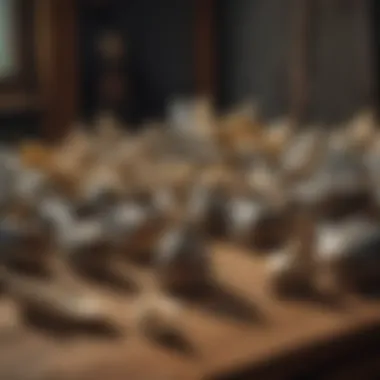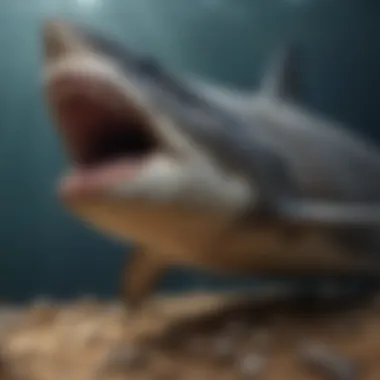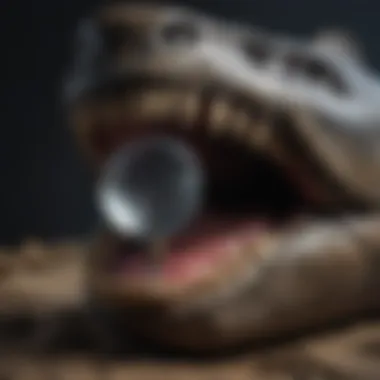Affordable Megalodon Teeth: A Collector's Guide


Intro
The world of megalodon teeth is a treasure trove for enthusiasts and collectors alike. These ancient relics tell a story that stretches back millions of years, capturing the imagination of many, whether they’re budding collectors or seasoned aficionados. The thrill of finding that perfect tooth, the one that speaks to the grandeur of the megalodon, can be exhilarating. However, navigating the market doesn’t have to break the bank. In this guide, we’ll delve deep into the fascinating realm of megalodon teeth, focusing on how to find affordable specimens without sacrificing quality or authenticity.
Rock and Fossil Identification
Identifying megalodon teeth among a sea of rocks and fossils can feel overwhelming, especially for newcomers. Understanding what to look for is essential in distinguishing genuine megalodon teeth from other similar fossils.
Types of Rocks and Fossils
Megalodon teeth are often found embedded in sediments near coastal regions or riverbeds. These locations are formed from limestone, sandstone, and shale. Here are some types you may encounter:
- Marine Sediments: Dark or light colors usually indicate marine origins.
- Fossilized Teeth: Their shiny, textured surfaces are telltale signs.
- Other Fossils: Shells and smaller fossilized fish bones can provide context to the environment where megalodon teeth are found.
Characteristics to Look For
When you're hunting for megalodon teeth, certain characteristics set them apart:
- Size: Megalodon teeth can range from a few inches to over seven inches in length.
- Shape: Triangular with serrated edges; the blade-like form stands out among other tooth types.
- Color: While they can exhibit a range of colors, black or dark brown hues are common due to mineral staining.
Tools for Identification
To ensure you're making the right call during your hunt, consider these handy tools:
- Hand Lens: A magnifying glass helps spot minute details.
- Field Guide: A portable reference can clarify what you’re looking at.
- Scale: Having a measuring tool can help confirm if it’s a megalodon tooth.
Collecting Tips and Techniques
Collecting megalodon teeth can be a rewarding venture if approached correctly.
Best Practices for Collecting
Here are some good habits to adopt:
- Be Respectful: Always adhere to local laws and regulations.
- Research: Knowing where to search is half the battle. Some famous locations include Florida and South Carolina for their rich fossil beds.
Locating Prime Collecting Sites
Finding the right spot greatly increases your chances:
- Beaches: Areas where sand can erode often expose buried relics.
- Riverbanks: During lower water levels, fossils can easily become visible.
- Construction Sites: Areas being dug up for new roads or buildings might reveal fossils that have lain hidden for years.
How to Safely Extract Specimens
Extraction should be done with care to avoid damaging the teeth:
- Use Tools: A small trowel can help. Avoid heavy-duty tools that might break the specimen.
- Gentle Digging: Always dig around the specimen instead of on top to minimize extraction harm.
Preservation and Display
Once you have your prized tooth, keeping it safe is paramount.
Techniques for Preserving Rocks and Fossils
Protecting your megalodon teeth from degradation is essential:
- Cleaning: Gently rinse your tooth in distilled water, avoiding detergents.
- Storing: Wrap in soft cloth and store in a dry place.


Proper Storage Methods
Keep them safe from scratches and dampness by:
- Display Cases: Consider getting a display case with UV protection aerially.
- Labeling: When storing, label each specimen with its origin and acquisition date for future reference.
Creative Display Ideas
Displaying your megalodon teeth can be both functional and artistic:
- Shadow Boxes: Create a visually appealing layout by combining photos and information about each tooth.
- Floating Frames: Present them in a way that makes the pieces float within the frame to highlight their beauty.
Geological Insights
Understanding the geological background of megalodon teeth can enrich your appreciation.
Geological Formations and Processes
Megalodon teeth form in specific geological environments.
- Formation: They often evolve in marine environments, typically found in layers of sediments laid down during prehistoric epochs.
Historical Significance of Rocks and Fossils
These fossils tell tales of Earth’s distant past, offering insights into marine ecosystems over millions of years. They represent not just evolution, but shifts in climate and environment.
Notable Discoveries in the Field
Plenty of remarkable discoveries have highlighted the significance of these ancient sharks, including:
- South Carolina: One of the hotbeds for finding large megalodon teeth.
- Florida’s Peace River: This spot has unearthed numerous intact specimens, making it a mecca for collectors.
Collecting megalodon teeth can genuinely open a door into understanding the prehistoric timeline, enriching one’s passion for geology and paleontology while building a striking collection of these ancient wonder.
Preamble to Megalodon Teeth
Megalodon teeth are more than mere remnants of a colossal predator; they serve as windows into the past and hold immense significance for both amateur enthusiasts and seasoned paleontologists. This article aims to provide a detailed overview of these fascinating fossils and their appeal in the collecting community. Understanding the various aspects of megalodon teeth—from their historical context to the fossilization process, from authenticity to preservation—equips collectors with the knowledge necessary for curating a thoughtful collection without breaking the bank.
Understanding Megalodon
The Megalodon, scientifically known as Carcharocles megalodon, was one of the largest and most formidable marine predators to ever roam the oceans. Believed to have existed from around 23 million to 3.6 million years ago, it was roughly three times the size of the modern great white shark. Its sheer size, estimated to reach lengths of up to 60 feet or more, makes its teeth, which could measure over 7 inches long, an awe-inspiring piece of natural history. The impressive dimensions of megalodon teeth serve not only as a testament to their terrifying predator but also as a significant draw for collectors.
Collectors are often intrigued by megalodon teeth for various reasons—including their intrinsic beauty and their historical value. These fossils may come with unique patterns and colors, which add to their appeal. Each tooth is like a badge from an ancient era, embodying the environment in which it thrived and the eventual prehistoric extinction that marked its end. Furthermore, they act as excellent conversation starters, allowing collectors to share their knowledge and passion with others in the community.
Fossilization Process
The journey from living biological material to fossil is intricate and often riddled with time. For megalodon teeth, fossilization occurs through a natural process called permineralization, in which organic material, like the dentin of the tooth, is gradually replaced by minerals over thousands to millions of years. This transformative process preserves the tooth's structure, allowing it to survive through geological epochs.
Fossilization specifically favors hard materials—hence why teeth, unlike other soft tissues, are more likely to be found. In addition, the environment plays a crucial role in this process. Teeth that end up in sediment-rich areas, such as riverbeds or ocean floors, are often the best-preserved due to the protective layers of silt and sediment that eventually cover them. Common sites for finding megalodon teeth include coastal regions where erosion exposes older layers of sediment.
Historical Context of Megalodon
Understanding the historical backdrop of the megalodon is crucial for collectors. It provides context to the significance of owning these fascinating teeth. The megalodon thrived during a time when the oceans were teeming with a diversity of life. Its existence has shaped not only the marine ecosystem but also our interpretation of prehistoric life. For collectors, this historical context enriches their connection to the fossils they acquire, giving life to past epochs.
Era of the Megalodon
The megalodon roamed the oceans approximately 15.9 to 2.6 million years ago, marking its dominance during the Cenozoic era, specifically in the Neogene period. This was a time of significant geological and climatic shifts, which affected marine habitats profoundly. Various factors, including the movement of tectonic plates and climate change, played a role in shaping the environment where megalodon thrived.


- Tectonic Activity: The rise of landmasses influenced ocean currents and marine circuits.
- Climate Fluctuations: Changes in temperature and sea levels created diverse ecological niches.
- Coexistence: The megalodon coexisted with other large marine predators, such as the predatory whale Livyatan and various species of large fish. Understanding these interactions can help collectors appreciate how megalodon teeth fit within a larger narrative of marine evolution.
This context also highlights the megalodon’s adaptability and evolutionary traits, such as its robust jaw and massive teeth, which were perfectly designed for hunting its prey. For those seeking to acquire megalodon teeth, recognizing their ancient origin adds a layer of importance and intrigue.
Importance in Paleontology
Megalodon teeth have a pivotal role in paleontological studies. Their size and structure offer insights into the species' diet, behavior, and ecological role in prehistoric oceans. Here are a few elements that underline their importance:
- Fossil Record: The megalodon provides a tangible connection to the past, serving as an important marker within the fossil record, allowing researchers to piece together a timeline of marine life.
- Ecological Insights: Analyzing wear patterns on their teeth reveals information about its prey and hunting strategies.
- Public Engagement: The immense size and ferocity of the megalodon capture public imagination, fostering interest in paleontology and natural history.
"Megalodon teeth are invaluable to understanding both the evolution of predatory behavior and the ecological dynamics of ancient marine environments."
Collectors interested in megalodon teeth not only acquire a physical piece of history but also participate in the broader narrative of ecological evolution and change. This connection enriches the collecting experience, making each tooth a symbol of deep time that offers stories waiting to be discovered.
Market Overview of Megalodon Teeth
When diving into the fascinating collectible world of megalodon teeth, understanding the market landscape becomes essential for both newcomers and seasoned collectors. The complexities of pricing, sourcing, and ensuring authenticity can make or break a collecting experience. Awareness of market trends and availability facilitates acquiring these stunning fossils without breaking the bank. Now, let’s dive into the intricate layers of pricing and where one might find these impressive specimens.
Price Ranges
Factors Influencing Price
The price of megalodon teeth can fluctuate like a flag in the wind, taken into account several crucial factors. First and foremost, the size of the tooth plays a significant role. Larger teeth often command a higher price simply because they are rarer and more desirable among collectors. Additionally, the condition is key; a tooth that is in pristine shape will be valued much higher than one with chips or fractures.
Another aspect to think about is the provenance of the tooth. If it comes from a well-known locality, it could draw more interest and thus, a heftier price tag. The age of the fossil can also sway what collectors are willing to pay. Rest assured, a tooth discovered in a reputable excavation site may be considered more valuable than one casually found at a beach.
Why is comprehending these factors beneficial? Knowing how these elements interact can empower you, the collector, to make informed decisions. By understanding what drives prices up and down, you can strategize your purchases, avoiding overpaying while shopping for megalodon teeth.
Comparative Analysis with Other Fossils
Taking a moment to consider how megalodon teeth stack up against other fossil types sheds light on their market appeal. For instance, compared to vertebrate fossils, megalodon teeth are often seen as more accessible and less expensive. They can frequently be found at lower price points than dinosaur bones or other significant museum pieces, making them popular among a wider audience of collectors.
The unique characteristic of megalodon teeth is their aesthetic value. A well-preserved megalodon tooth can make a striking display piece that might outshine other fossils, even those considered more valuable in scientific terms. This visual appeal enhances their popularity among collectors who may be drawn more to aesthetics than strictly historical significance.
While price comparisons are insightful, they also come with disadvantages. The allure of megalodon teeth can sometimes lead to inflated prices, especially on the internet, where sellers may overestimate worth based on demand. Collectors must tread carefully and conduct thorough research to avoid falling down that rabbit hole.
Where to Find Affordable Options
Online Marketplaces
Online marketplaces present a treasure trove of options for collectors eager to snag megalodon teeth at reasonable prices. Websites like eBay or Etsy often have listings from various sellers, each with unique specimens at differing price ranges. The online shopping experience allows you to compare prices easily and find deals that fit your budget.
A significant benefit of online marketplaces is that they often feature customer reviews, acting as a guide to assess seller reputability. One can quickly gauge what others have said about their purchasing experience, which can be key when hunting down that perfect tooth.
However, there are some risks associated with online buying. Without being able to physically inspect the tooth, there’s a chance of encountering untrustworthy vendors. Always look for sellers who provide multiple clear photographs and transparent descriptions to ensure a smooth transaction.
Local Gem and Mineral Shows
Local gem and mineral shows can be a goldmine for collectors seeking affordable megalodon teeth. These events often attract a plethora of vendors, with prices that may even be negotiable. Unlike the often fixed pricing of online marketplaces, you have the chance to haggle a bit, which could lead to substantial savings.
Additionally, attending these shows offers the invaluable opportunity to connect directly with knowledgeable sellers. You can ask questions, inspect the teeth closely, and learn about their origins firsthand. This face-to-face interaction can enhance your confidence in purchasing, as you can build a rapport with sellers who may share tips on authenticity and preservation.
On the flip side, gem shows can sometimes be overwhelming with so many choices to sift through. It’s easy to get caught up in the excitement and possibly spend more than intended. Setting a budget beforehand can help keep your spending in check while still allowing for the thrill of discovery.
Ultimately, a sound understanding of the market dynamics and where to find megalodon teeth can significantly enhance your collecting journey. Grasping pricing factors and sourcing options can elevate the overall experience and pave the way for a fulfilling addition to any fossil collection.
Authenticity and Verification


Authenticity is a cornerstone in the realm of megalodon teeth collecting. For enthusiasts, ensuring that the specimens acquired are genuine is not just a matter of pride, but it also directly influences the value and integrity of one's collection. In a market passionate about these ancient relics, being able to discern the real from the fake is essential, as not only do false fossils undermine the efforts of collectors, they can also dilute the significance that accompanies genuine pieces. Verification is more than a formality; it’s an educated measure meant to safeguard investments and enhance the joy of collecting.
Identifying Genuine Fossils
To distinguish authentic megalodon teeth from forgeries requires a keen eye and a bit of knowledge. Here are some telltale signs to help identify real specimens:
- Color and Texture: Authentic megalodon teeth often exhibit a rich, dark coloration, typically deep black, brown, or even shades of green. The texture is usually smooth with a slight sheen, owing to the fossilization process that occurs over millions of years.
- Root Structure: One of the most distinguishing characteristics of a genuine tooth is its root. Natural megalodon teeth have a well-defined and unique root shape, which differs significantly from forgeries.
- Wear Patterns: Real teeth can show wear patterns consistent with natural use, whereas fakes often look overly pristine or too perfectly shaped. Look for slight chips or natural imperfections.
- Weight: Genuine teeth can feel heavier than they look, due to their dense fossil composition.
If in doubt, consider seeking guidance from experienced collectors or professional appraisals.
Common Forgery Techniques
Forgeries are becoming increasingly sophisticated, which is why awareness of common techniques used by counterfeiters is crucial. Recognizing these strategies enables collectors to more effectively shield themselves from deception:
- Casting Techniques: Many fakes originate from molds created from real teeth. This method allows for the replication of details but often lacks the authentic aging and coloration of true fossils.
- Resin Coating: Some forgers use resin or synthetic materials to enhance the appearance of a tooth. If a specimen feels slick or has an unnatural gloss, it may well be a trap.
- Inconsistent Patterns: If you notice odd patterns or markings that seem too uniform, it’s a red flag. Natural fossils exhibit variations that tell their unique story, while forgeries tend to look overly consistent.
"The thrill of the hunt can quickly become a misadventure if one is not careful to verify the authenticity of megalodon teeth before purchase."
Being educated about these points is one way to bolster a collection's value and ensure the credibility of each piece. As collectors, the onus lies on us to cultivate a discerning eye and a deeper understanding of what we pursue.
Preservation and Display of Megalodon Teeth
Collecting megalodon teeth is an escapade of sorts, rich with history and wonder. However, to truly appreciate these ancient treasures, proper preservation and display techniques are crucial. Not only does this enhance the aesthetic value of your collection, but it also safeguards your investments against wear and tear. Remember, the goal isn't just to collect but to ensure the longevity and beauty of each piece you own.
Storage Techniques
Storing megalodon teeth requires a blend of care and practicality. Given their unique structures and sizes, here are a few methods to consider:
- Protective Cases: Invest in high-quality display cases that offer both visibility and protection. Acrylic cases are a popular choice as they allow for 360-degree viewing while thwarting dust and scratches. It'll keep your teeth looking sharp.
- Soft Support: When storing in boxes, use soft materials like cotton or felt for cushioning. You wouldn't want your teeth clattering around like loose change in your pocket.
- Temperature Control: A stable environment works wonders. Amino acids and other compounds in fossils are sensitive to drastic changes in temperature or humidity. Keep your collection in a cool, dry place to prevent damage
- Avoid Chemicals: Similar to keeping wine away from strong odors, keep your megalodon teeth away from harsh chemicals. Some cleaning agents can harm the fossils over time.
Creative Display Ideas
Once you have your teeth well-protected, it’s time to show them off! Creative displays can turn an ordinary area into a captivating focal point. Here are some imaginative ideas:
- Shadow Boxes: Create shadow boxes that highlight the megalodon tooth as the centerpiece. Surround it with marine-themed decor, perhaps faux coral or even sand, to transport viewers back to the prehistoric ocean.
- Wall Mounts: Consider mounting teeth on the wall. Using simple hooks or attaching them in a frame can transform an empty wall into an exhibition of ancient history.
- Themed Displays: Cultivate an entire marine collection. Pair your megalodon teeth with models of prehistoric sea creatures or informative plaques detailing their history. Put a little extra effort if you're hosting guests—to share something truly educational and entertaining.
"Each megalodon tooth tells a story; how you choose to display it can amplify that narrative."
- Rotating Displays: If you have multiple specimens, consider a rotating display. This not only keeps your setup fresh but also allows each tooth to take center stage in its moment.
With the right storage and imaginative display techniques, megalodon teeth can become a conversation starter, a personal museum showcasing prehistoric wonders. Through proper care and creativity, you can not only preserve their integrity but also elevate your collecting experience.
Responsibility in Collecting
When it comes to collecting megalodon teeth, responsibility plays a critical role in ensuring that the hobby is both enjoyable and sustainable. As with any collecting venture, understanding the broader implications of acquiring fossils is paramount. This includes recognizing the ethical and legal factors that surround fossil collections, which can greatly affect the industry and the ongoing preservation of natural history.
One of the benefits of exercising responsibility is the respect it brings to the collecting community. A conscientious collector not only cultivates a positive image but also inspires others to follow suit. This can help in fostering a culture of ethical collecting where the focus isn’t just on accumulation but also on understanding and respecting the origins and implications of those teeth.
Moreover, responsible collecting aids in preserving ecosystems. Many fossil sites can be sensitive environments, and engaging in practices that protect these locations ensures future generations can experience the same wonders. Being mindful of collecting practices may also involve supporting sites or vendors that demonstrate awareness and care for ecological balance.
"It's not just about what you can find, but also about protecting what remains."
There are specific elements to focus on when discussing responsibility, primarily centered around the ethics that guide our actions and the legalities that shape how we can collect as hobbyists. Let's now delve deeper into these essential aspects.
The End
As we wrap up our journey into the world of megalodon teeth, it’s clear that collecting these prehistoric marvels offers not just a glimpse into Earth's distant past but also provides a fulfilling hobby for enthusiasts. The satisfaction of acquiring a genuine megalodon tooth, particularly at an affordable price, should not be underestimated. It's not merely about owning a piece of history, but also about the stories and knowledge that come with each specimen.
Future of Collecting Megalodon Teeth
The future of collecting megalodon teeth seems bright, especially as the demand for these extraordinary fossils continues to grow. With increased access to online marketplaces like Facebook and various forums, collectors can share tips, showcase their finds, and connect with fellow enthusiasts. The sense of community among collectors has transformed the hunt for megalodon teeth into a shared adventure, enhancing the entire experience.
Additionally, as new excavation sites are discovered, fresh specimens will undoubtedly emerge on the market. This influx could make it a bit easier for novice collectors to dive in without breaking the bank. However, potential buyers must stay vigilant, ensuring they have the knowledge to distinguish between genuine artifacts and forgeries.
- Educational Resources: Utilizing platforms like Reddit and educational websites can provide valuable insights into the authenticity and value of these fossils.
- Conservation Efforts: The importance of ethical collecting is gaining traction, propelling conversations around sustainable excavation and responsible ownership. Collectors are beginning to appreciate not only the monetary value of these teeth but also their ecological and historical significance.







